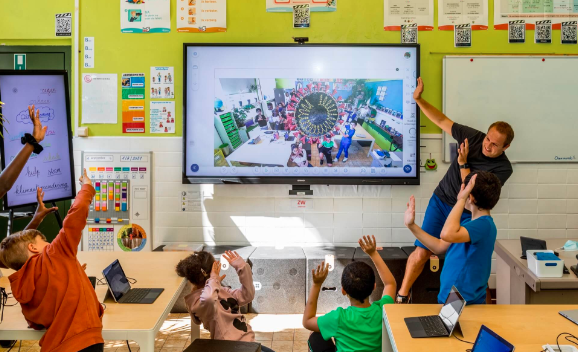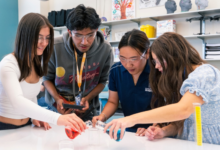The Future of Classroom Technology: Interactive Flat Panel Displays as the Core Tool for Learning

The classroom of tomorrow is here today, and at the heart of this transformation is the interactive flat panel display. As schools move away from traditional teaching methods and embrace the digital age, interactive flat panels are becoming the centerpiece of modern education. These versatile, touch-enabled displays are not just replacing whiteboards and projectors; they are redefining how students learn and how teachers teach, making learning more engaging, interactive, and effective.
Why Interactive Flat Panel Displays Are Transforming Classrooms
Interactive flat panel display (IFPD) are large touchscreen devices that function as powerful digital whiteboards, enabling teachers to present lessons in more dynamic and engaging ways. But they do far more than display content—they create a two-way interaction that encourages students to participate, collaborate, and take control of their learning experience.
Here’s why interactive flat panel displays are becoming the core tool for learning:
- Engaging and Interactive Learning: Unlike traditional teaching tools, IFPDs bring lessons to life with vibrant visuals, touch interaction, and multimedia integration. For example, in a biology class, students can explore the human body by interacting with 3D models on the screen, zooming in on organs, and examining functions in real time. This hands-on approach makes complex concepts easier to understand and keeps students actively engaged, turning passive learning into an immersive experience.
- Personalized Learning for Every Student: Every student learns differently, and IFPDs support differentiated instruction by allowing teachers to tailor lessons to meet individual needs. Teachers can easily access a wide range of resources, from videos to interactive simulations, catering to different learning styles—whether visual, auditory, or kinesthetic. For instance, struggling readers can benefit from interactive stories with audio support, while advanced learners can dive deeper into interactive exercises that challenge their skills.
- Seamless Integration with Digital Resources: Interactive flat panels are not standalone tools; they connect seamlessly with other educational technologies, including tablets, laptops, and educational apps. Teachers can pull up web-based resources, access cloud-stored lesson plans, and even connect to virtual classrooms, making the IFPD a hub for all learning activities. In a math class, for example, students can solve problems on their tablets and have their work displayed in real time on the panel, allowing for instant feedback and collaborative problem-solving.
- Enhanced Collaboration and Group Work: One of the standout features of IFPDs is their ability to support collaborative learning. Multiple students can interact with the screen simultaneously, making group work more dynamic and engaging. In a history class, students can work together to build interactive timelines, annotate maps, and present their findings. This level of collaboration not only enhances learning but also builds critical skills like teamwork, communication, and problem-solving.
- Real-Time Feedback and Assessment: Interactive flat panel displays enable teachers to provide immediate feedback during lessons, enhancing the learning process. With tools like interactive quizzes and polls, teachers can gauge student understanding in real time and adjust their teaching accordingly. For example, after a lesson on chemical reactions, a teacher can use the panel to conduct a quick quiz, instantly reviewing the class’s responses and addressing any misconceptions. This immediate feedback loop helps students learn more effectively and keeps them engaged.
- Future-Proof Learning Environment: As technology continues to evolve, schools need tools that are adaptable and future-proof. IFPDs are designed to grow with technology, offering regular software updates, compatibility with new educational apps, and integration with emerging technologies like augmented reality (AR) and artificial intelligence (AI). This adaptability ensures that interactive flat panels remain relevant, keeping classrooms on the cutting edge of educational innovation.
Read also: What role does technology play in education reform in the USA?
Real-World Impact: Success Stories of Interactive Flat Panels
Schools around the world are experiencing the transformative power of interactive flat panel displays. In a middle school in California, the introduction of IFPDs led to a noticeable increase in student participation and academic performance. Teachers reported that students were more engaged during lessons, particularly in subjects like math and science, where interactive visuals and simulations helped demystify complex topics.
In another case, a primary school in the UK used interactive flat panels to support hybrid learning during the pandemic. Teachers used the displays to connect with students at home, conduct live lessons, and provide real-time feedback. This seamless blend of in-class and remote learning demonstrated the versatility of IFPDs and highlighted their role as essential tools in maintaining continuity of education.
The Future of Learning: What’s Next for Interactive Flat Panels?
The future of classroom technology lies in the continued evolution of interactive flat panels. As these displays integrate with advanced technologies like AR, AI, and cloud computing, they will open new possibilities for personalized, data-driven learning. Imagine a classroom where students can use AR through the IFPD to explore historical events as if they were there, or where AI algorithms suggest personalized learning paths based on real-time assessments.
Moreover, the increasing focus on STEM education will drive further adoption of IFPDs, as they provide the perfect platform for coding, robotics, and other tech-based subjects. These panels make it easier for students to experiment, iterate, and learn through trial and error—key components of a modern STEM education.
Conclusion: Interactive Flat Panels as the Core of Modern Learning
Interactive flat panel displays are more than just a technological upgrade—they are a paradigm shift in how education is delivered. By making learning more interactive, collaborative, and accessible, they empower both teachers and students to engage deeply with the content and with each other. IFPDs are not just enhancing education; they are redefining it, making the classroom a vibrant, dynamic environment where every student can thrive.
As schools continue to embrace this technology, interactive flat panels will undoubtedly become the cornerstone of modern education, paving the way for a future where every classroom is equipped with the tools needed to inspire, educate, and prepare students for the world ahead. The future of learning is bright, and interactive flat panel displays are leading the charge, transforming classrooms into centers of innovation and discovery.





